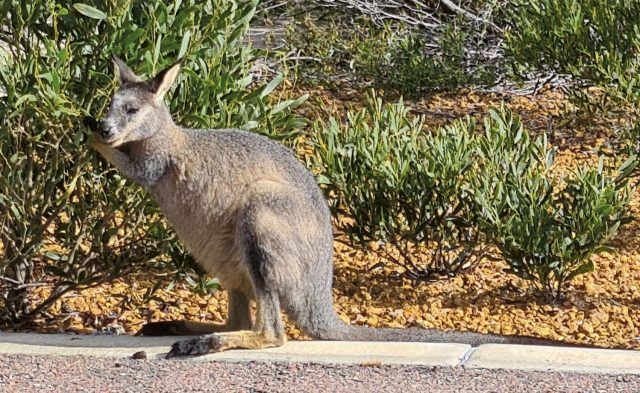Chittering Wildlife Carers are concentrating on a new wildlife character every six months (see last month’s NVN on Operation Wallaby). Until September we will be getting to know wallabies – specifically the Western Brush Wallaby (Notamacropus irma), also known as the Black Gloved Wallaby due to the black ends of it’s fore and hind limbs.
Very little detailed information can be found about this animal and more research is needed. Their numbers decreased at an alarming rate until the early 1970’s when foxes were targeted by aerial baiting. Their numbers have now slowly increased although continued clearing has forced them to find new feeding areas leaving them classed as near to Endangered.
The body is grey with a definite white stripe going from the ear to the corner of its mouth which helps to distinguish the Wallaby from a young Western Grey Kangaroo (Macropus fuliginosus). Some wallabies might also have pale stripes on the flank. When fleeing from danger their gait is quite different from kangaroos, with head down low and the tail straight out rather than the upright gait of most macropods.
Wallabies are exceptionally agile and thrive well in the open forested and rocky areas of our south-western region including the Darling Scarp in the Chittering area. They are herbivores enjoying predominately grasses with some bush. Their most active times are at dawn and dusk (which unfortunately leaves them at risk on roads).
Mating season occurs in summer with birthing occurring after about 31 days(in April and May). The mother gives birth by sitting with her tail between her legs. The very immature joey, about the size of a jelly bean, crawls up the mother’s fur and into the pouch where it immediately firmly attaches itself to one of several teats.
The joey remains in the pouch for about 6-7 months, returning to the pouch when it wants a drink or is frightened. Females reach maturity at about 18 months while males are a little older at 20-24 months.
If you are lucky enough to spot a Western Brush Wallaby (even a dead one) please contact Ann on 0427 992 099 or email ann.rufftuff@hotmail.com with details of location and circumstance. This information can then be added to on-going research.








